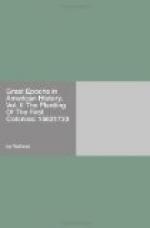(1664)
BY JOHN R. BRODHEAD[1]
England now determined boldly to rob Holland of her American province. King Charles II accordingly sealed a patent granting to the Duke of York and Albany a large territory in America, comprehending Long Island and the islands in its neighborhood—his title to which Lord Stirling had released—and all the lands and rivers from the west side of the Connecticut River to the east side of Delaware Bay. This sweeping grant included the whole of New Netherlands and a part of the territory of Connecticut, which, two years before, Charles had confirmed to Winthrop and his associates.
The Duke of York lost no time in giving effect to his patent. As lord high admiral he directed the fleet. Four ships, the Guinea, of thirty-six guns; the Elias, of thirty; the Martin, of sixteen; and the William and Nicholas, of ten, were detached for service against New Netherlands, and about four hundred fifty regular soldiers, with their officers, were embarked. The command of the expedition was intrusted to Colonel Richard Nicolls, a faithful Royalist, who had served under Turenne with James, and had been made one of the gentlemen of his bedchamber. Nicolls was also appointed to be the Duke’s deputy-governor, after the Dutch possessions should have been reduced.
With Nicolls were associated Sir Robert Carr, Colonel George Cartwright, and Samuel Maverick, as royal commissioners to visit the several colonies in New England. These commissioners were furnished with detailed instructions; and the New England governments were required by royal letters to “join and assist them vigorously” in reducing the Dutch to subjection. A month after the departure of the squadron the Duke of York conveyed to Lord Berkeley and Sir George Carteret all the territory between the Hudson and Delaware Rivers, from Cape May north to 41 deg. 40’ latitude, and thence to the Hudson, in 41 deg. latitude, “hereafter to be called by the name or names of Nova Caesarea or New Jersey.”
Intelligence from Boston that an English expedition against New Netherlands had sailed from Portsmouth was soon communicated to Stuyvesant by Captain Thomas Willett; and the burgomasters and schepens of New Amsterdam were summoned to assist the council with their advice. The capital was ordered to be put in a state of defense, guards to be maintained, and schippers to be warned. As there was very little powder at Fort Amsterdam a supply was demanded from New Amstel, and a loan of five or six thousand guilders was asked from Rensselaerswyck. The ships about to sail for Curacao were stopt; agents were sent to purchase provisions at New Haven; and as the enemy was expected to approach through Long Island Sound, spies were sent to obtain intelligence at West Chester and Milford.




